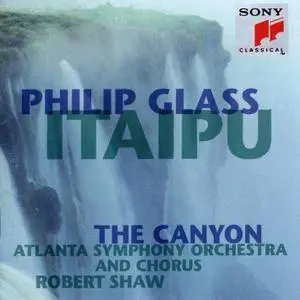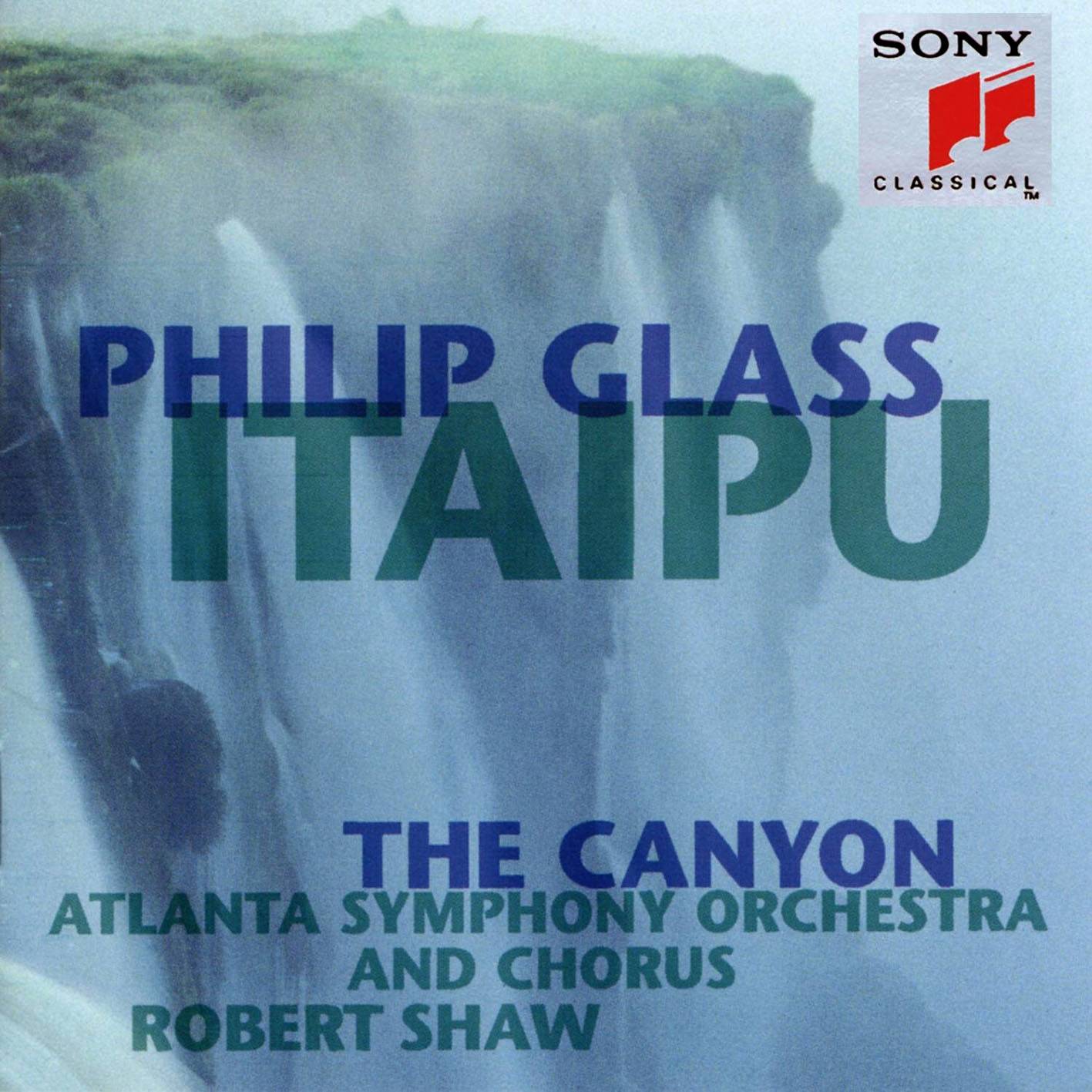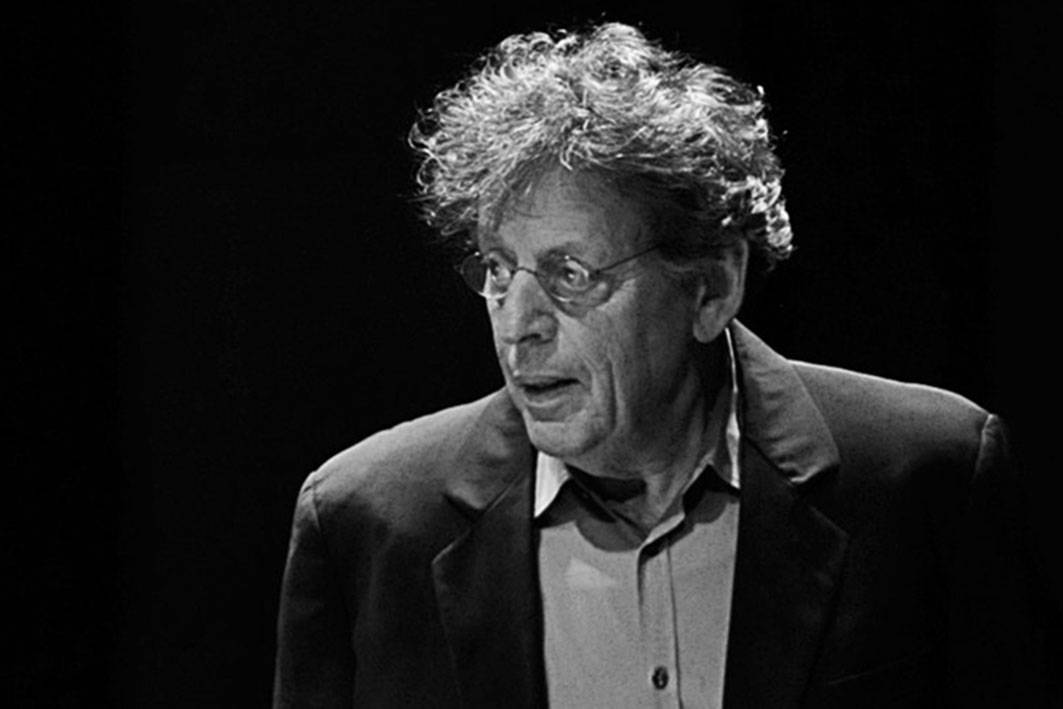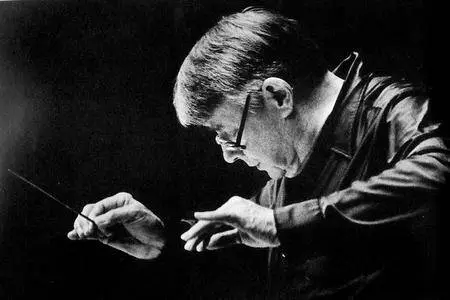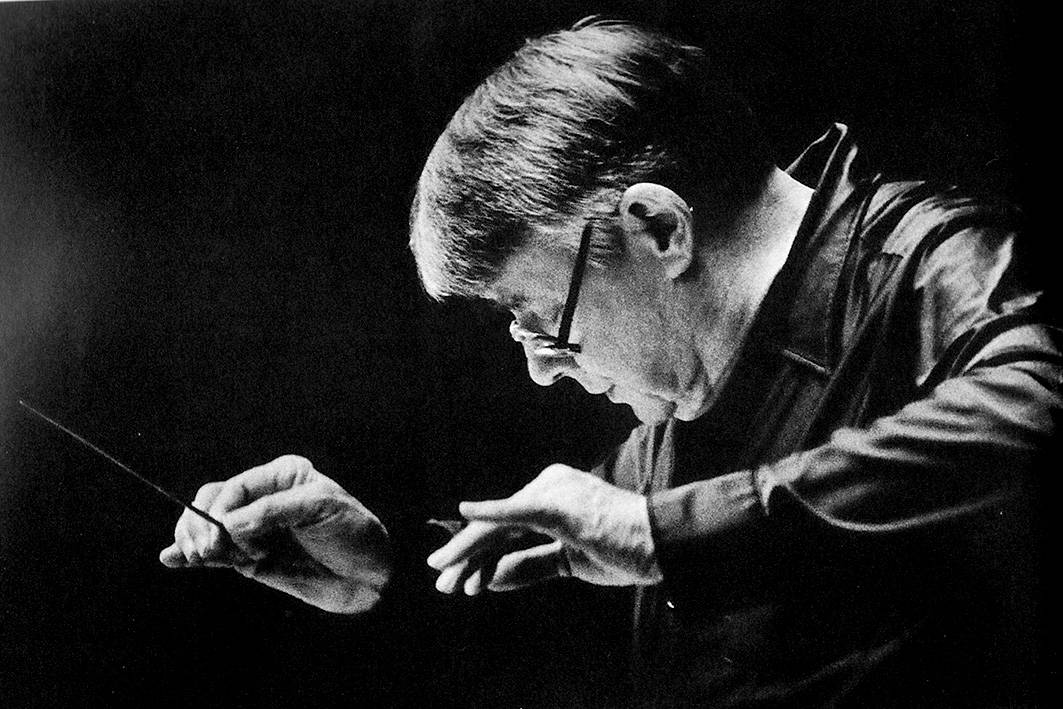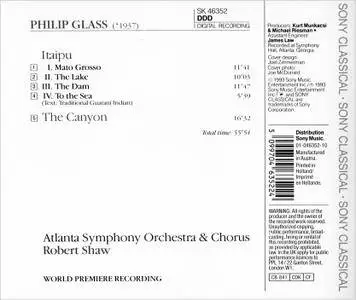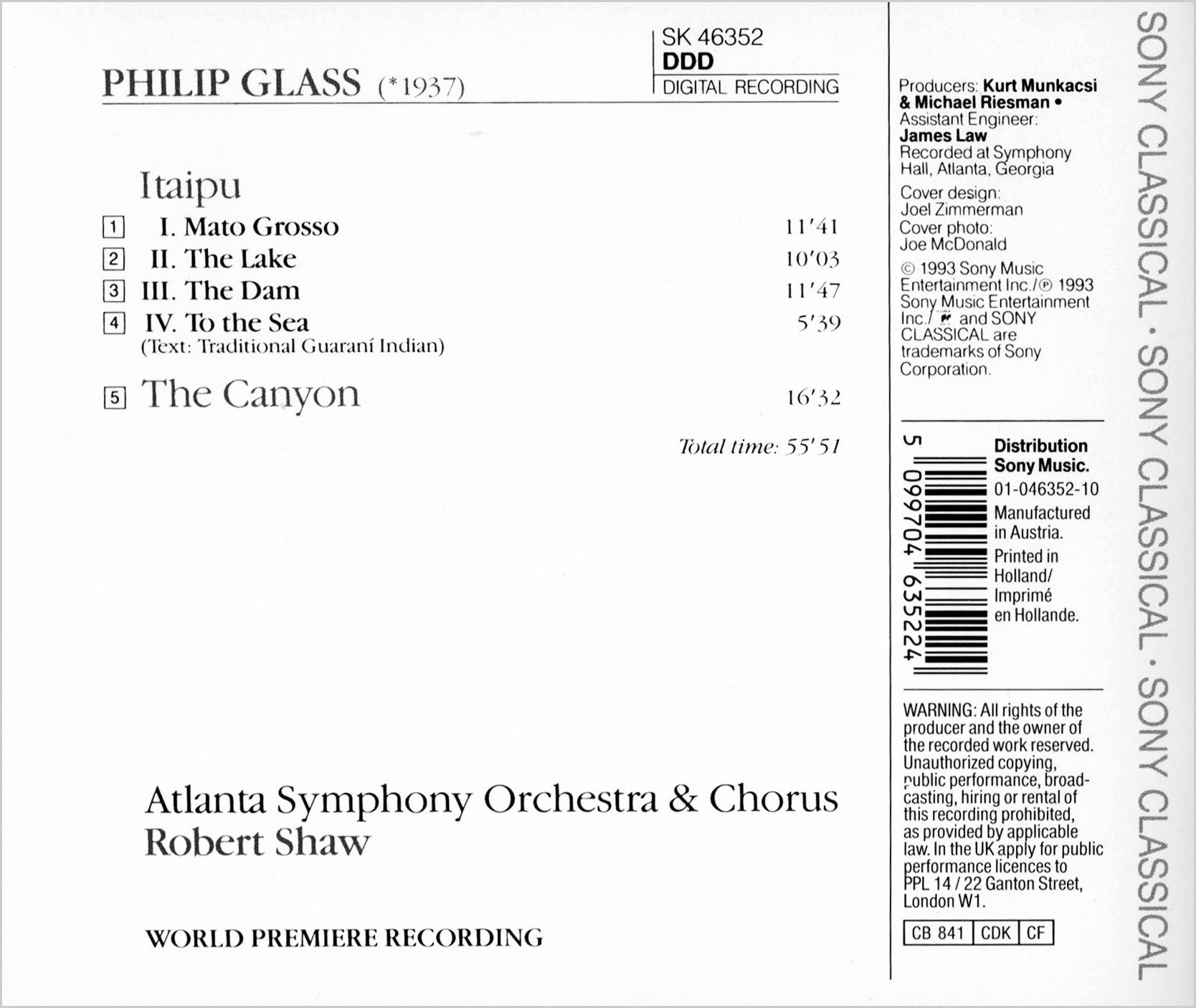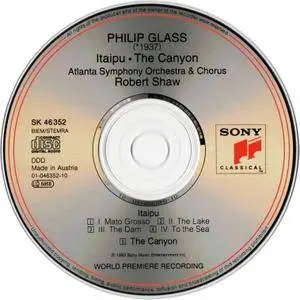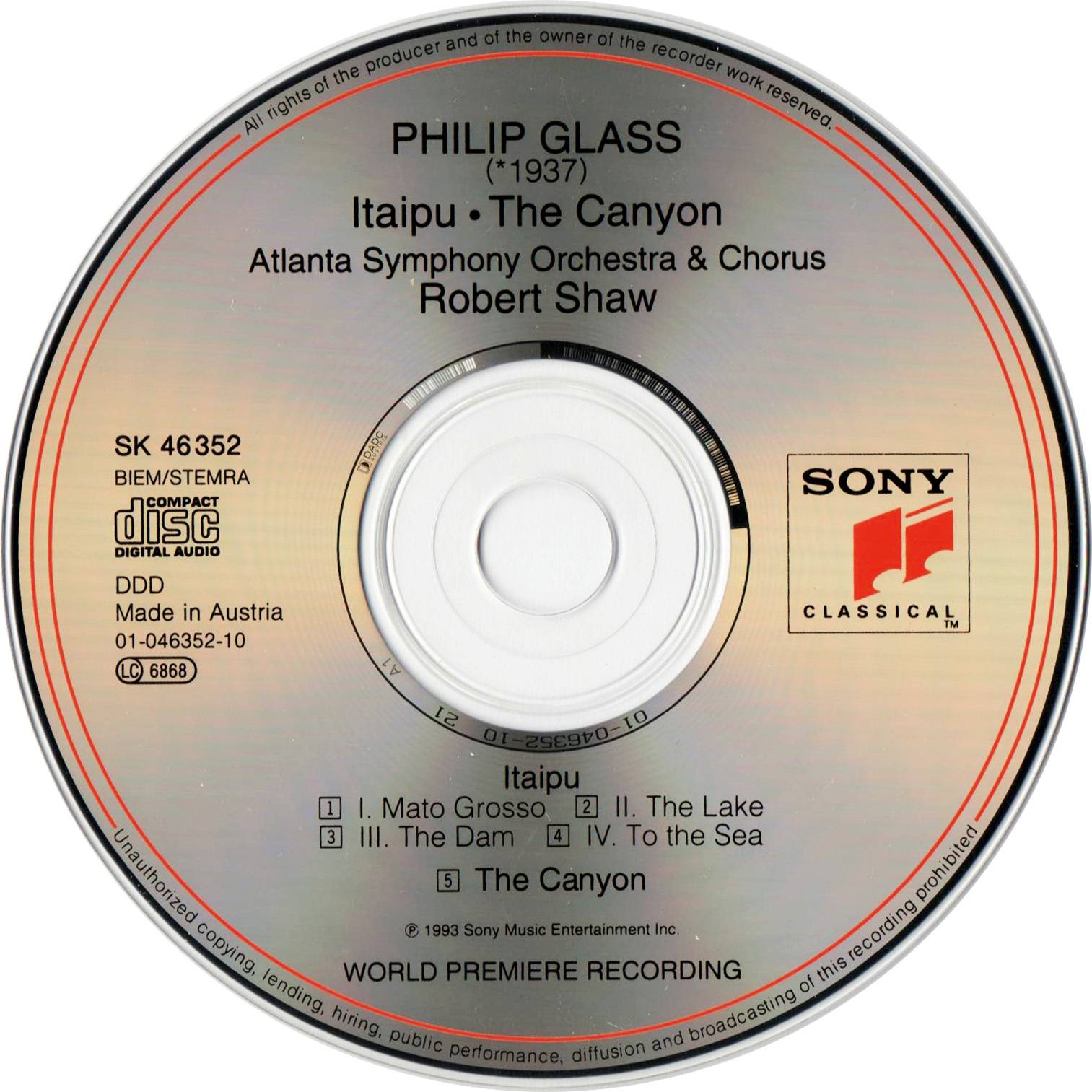Philip Glass: Itaipu; The Canyon (1993)
Atlanta Symphony Orchestra & Chorus, conducted by Robert Shaw
EAC | FLAC | Image (Cue&Log) ~ 285 Mb | Mp3 (CBR320) ~ 187 Mb | Scans included
Classical, Minimalism, Choral | Label: Sony Classical | # SK 46352 | 00:55:52
Atlanta Symphony Orchestra & Chorus, conducted by Robert Shaw
EAC | FLAC | Image (Cue&Log) ~ 285 Mb | Mp3 (CBR320) ~ 187 Mb | Scans included
Classical, Minimalism, Choral | Label: Sony Classical | # SK 46352 | 00:55:52
Itaipu (1989) is something of a cantata-cum-symphony-cum-oratorio with no clear text. Its topic is the world's largest hydroelectric dam, built on the Rarana River between Paraguay and Brazil, and the piece–in Glass's trademark punctuating minimalism–is filled with distinct South American instrumentation, particularly in the percussion. The music itself is noble, conjuring the human endeavor to build the five-mile-wide dam near the town of Itaipu. The Canyon (1988) is about no canyon in particular but tonally suggests the mystery of canyons in general. Both these compositions are among Glass's better works.Review by Paul Cook
It seems that the more crowded our daily lives become, the more we crave space. And space is indeed central to the work of most composers who have cultivated minimalist techniques: Reich Gorecki, Kancheli, MacMillan, Bryars and Glass all employ it as an essential creative constituent, and all have in some way managed to reclaim it for our own claustrophobic imaginations.
The idea of spacious natural vistas has always been central to the work of Philip Glass. Itaipu, and The Canyon are the second and third of his ''portraits of nature'', the former being a commission from the Atlanta Symphony Orchestra and Chorus, while the latter was composed specifically for the Rotterdam Philharmonic. Itaipu is located on the Parana River, which in turn forms the border between Brazil and Paraguay. It is the location of a massive hydro-electric dam with individual generators large enough to house a full symphony orchestra. So it's little wonder that Itaipu provided Glass with instant inspiration.
The score itself is divided into four separate sections and calls on substantial orchestral and choral forces. Although consistent with Glass's other work (the pulse is more or less constant, the harmonic computations simple but telling), Itaipu has an especially dark, rugged tonal profile. The first movement combines chant-like choral writing with exotic-sounding winds, swirling string figurations and subtle percussion writing; the second has the strongest melodic appeal (especially at the very opening), bird-like woodwind arabesques, characteristically pumping low brass and a closing string sequence (9'23'') strongly reminiscent of Nielsen's Fifth Symphony. The final movement, ''To the Sea'', is the shortest and possibly the most mysterious of the four; but the hub of the work—''The Dam'' itself—is in the third movement, where from 6'05'' onwards, brass and winds abet a pounding ostinato and a series of modulations redolent of such scenically aware late-romantics as Sibelius, Bruckner and Roy Harris. It's one of the most arresting passages in Glass's output and gives a vivid impression of the dam's overwhelming physical presence.
Itaipu sets Guarani Indian texts, although Glass intended that the words support the music, rather than vice versa. The Canyon is purely orchestral, and much shorter. It's built around two basic ideas, with a jagged middle section that heats up for a powerful climax. Less heavily scored than Itaipu, The Canyon utilizes a large array of percussion, which Glass exploits with his usual ear for nuance. But Itaipu is definitely the disc's main 'event'—a patient, cumulatively powerful essay, easily assimilated and well enough crafted to repay repeated listening. Those who find certam other of Glass's works monotonous and uneventful (and I indude myself among their ranks) would do well to sample it. The recordings are cleanly balanced, the performances neat—but I hope that one day we might be granted a more forceful projection of Itaipu. Recommended, especially to those not normally 'behind Glass'.'Review by Gramophone
Atlanta Symphony Chorus
Atlanta Symphony Orchestra
Robert Shaw - conductor
Tracklist:
Itaipú
A symphonic portrait for chorus and orchestra
in four movements
01. I. Mato Grosso (11:42)
02. II. The Lake (10:03)
03. III. The Dam (11:47)
04. IV. To the Sea (5:48)
05. The Canyon (16:33)
A dramatic episode for orchestra
Exact Audio Copy V1.0 beta 3 from 29. August 2011
EAC extraction logfile from 22. October 2012, 18:43
Robert Shaw / Philip Glass – Itaipu; The Canyon – Robert Shaw
Used drive : TSSTcorpCDDVDW SH-222BB Adapter: 2 ID: 1
Read mode : Secure
Utilize accurate stream : Yes
Defeat audio cache : Yes
Make use of C2 pointers : No
Read offset correction : 6
Overread into Lead-In and Lead-Out : No
Fill up missing offset samples with silence : Yes
Delete leading and trailing silent blocks : No
Null samples used in CRC calculations : Yes
Used interface : Native Win32 interface for Win NT & 2000
Used output format : User Defined Encoder
Selected bitrate : 1024 kBit/s
Quality : High
Add ID3 tag : No
Command line compressor : C:\Program Files\Exact Audio Copy\Flac\flac.exe
Additional command line options : -8 -V -T "TITLE=%title%" -T "ARTIST=%artist%" -T "ALBUMARTIST=%albumartist%" -T "ALBUM=%albumtitle%" -T "DATE=%year%" -T "TRACKNUMBER=%tracknr%" -T "TRACKTOTAL=%numtracks%" -T "GENRE=%genre%" -T "COMMENT=%comment%" -T "PERFORMER=%albuminterpret%" -T "COMPOSER=%composer%" %source% -o %dest%
TOC of the extracted CD
Track | Start | Length | Start sector | End sector
––––––––––––––––––––––––––––-
1 | 0:00.00 | 11:41.57 | 0 | 52631
2 | 11:41.57 | 10:02.50 | 52632 | 97831
3 | 21:44.32 | 11:47.30 | 97832 | 150886
4 | 33:31.62 | 5:47.53 | 150887 | 176964
5 | 39:19.40 | 16:33.02 | 176965 | 251441
Range status and errors
Selected range
Filename G:\Ripped general\[1255] Philip Glass – Itaipu; The Canyon – Robert Shaw\Philip Glass – Itaipu; The Canyon – Robert Shaw.wav
Peak level 77.6 %
Extraction speed 6.9 X
Range quality 99.9 %
Test CRC 1920686E
Copy CRC 1920686E
Copy OK
No errors occurred
AccurateRip summary
Track 1 accurately ripped (confidence 2) [22B0EED5] (AR v2)
Track 2 accurately ripped (confidence 2) [AEBC1DF8] (AR v2)
Track 3 accurately ripped (confidence 2) [1E3BFE77] (AR v2)
Track 4 accurately ripped (confidence 21) [F32724F1] (AR v1)
Track 5 accurately ripped (confidence 22) [18407510] (AR v1)
All tracks accurately ripped
End of status report
EAC extraction logfile from 22. October 2012, 18:43
Robert Shaw / Philip Glass – Itaipu; The Canyon – Robert Shaw
Used drive : TSSTcorpCDDVDW SH-222BB Adapter: 2 ID: 1
Read mode : Secure
Utilize accurate stream : Yes
Defeat audio cache : Yes
Make use of C2 pointers : No
Read offset correction : 6
Overread into Lead-In and Lead-Out : No
Fill up missing offset samples with silence : Yes
Delete leading and trailing silent blocks : No
Null samples used in CRC calculations : Yes
Used interface : Native Win32 interface for Win NT & 2000
Used output format : User Defined Encoder
Selected bitrate : 1024 kBit/s
Quality : High
Add ID3 tag : No
Command line compressor : C:\Program Files\Exact Audio Copy\Flac\flac.exe
Additional command line options : -8 -V -T "TITLE=%title%" -T "ARTIST=%artist%" -T "ALBUMARTIST=%albumartist%" -T "ALBUM=%albumtitle%" -T "DATE=%year%" -T "TRACKNUMBER=%tracknr%" -T "TRACKTOTAL=%numtracks%" -T "GENRE=%genre%" -T "COMMENT=%comment%" -T "PERFORMER=%albuminterpret%" -T "COMPOSER=%composer%" %source% -o %dest%
TOC of the extracted CD
Track | Start | Length | Start sector | End sector
––––––––––––––––––––––––––––-
1 | 0:00.00 | 11:41.57 | 0 | 52631
2 | 11:41.57 | 10:02.50 | 52632 | 97831
3 | 21:44.32 | 11:47.30 | 97832 | 150886
4 | 33:31.62 | 5:47.53 | 150887 | 176964
5 | 39:19.40 | 16:33.02 | 176965 | 251441
Range status and errors
Selected range
Filename G:\Ripped general\[1255] Philip Glass – Itaipu; The Canyon – Robert Shaw\Philip Glass – Itaipu; The Canyon – Robert Shaw.wav
Peak level 77.6 %
Extraction speed 6.9 X
Range quality 99.9 %
Test CRC 1920686E
Copy CRC 1920686E
Copy OK
No errors occurred
AccurateRip summary
Track 1 accurately ripped (confidence 2) [22B0EED5] (AR v2)
Track 2 accurately ripped (confidence 2) [AEBC1DF8] (AR v2)
Track 3 accurately ripped (confidence 2) [1E3BFE77] (AR v2)
Track 4 accurately ripped (confidence 21) [F32724F1] (AR v1)
Track 5 accurately ripped (confidence 22) [18407510] (AR v1)
All tracks accurately ripped
End of status report
foobar2000 1.2 / Dynamic Range Meter 1.1.1
log date: 2017-05-14 01:53:58
––––––––––––––––––––––––––––––––––––––––
Analyzed: Atlanta Symphony Orchestra, Robert Shaw & Philip Glass / Philip Glass – Itaipu; The Canyon – Robert Shaw
––––––––––––––––––––––––––––––––––––––––
DR Peak RMS Duration Track
––––––––––––––––––––––––––––––––––––––––
DR13 -3.81 dB -22.27 dB 11:42 01-Itaipu: I. Mato Grosso
DR12 -7.67 dB -26.29 dB 10:03 02-Itaipu: II. The Lake
DR13 -3.65 dB -20.95 dB 11:47 03-Itaipu: III. The Dam
DR12 -3.67 dB -24.15 dB 5:48 04-Itaipu: IV. To the Sea
DR15 -2.19 dB -22.88 dB 16:33 05-The Canyon
––––––––––––––––––––––––––––––––––––––––
Number of tracks: 5
Official DR value: DR13
Samplerate: 44100 Hz
Channels: 2
Bits per sample: 16
Bitrate: 640 kbps
Codec: FLAC
================================================================================
log date: 2017-05-14 01:53:58
––––––––––––––––––––––––––––––––––––––––
Analyzed: Atlanta Symphony Orchestra, Robert Shaw & Philip Glass / Philip Glass – Itaipu; The Canyon – Robert Shaw
––––––––––––––––––––––––––––––––––––––––
DR Peak RMS Duration Track
––––––––––––––––––––––––––––––––––––––––
DR13 -3.81 dB -22.27 dB 11:42 01-Itaipu: I. Mato Grosso
DR12 -7.67 dB -26.29 dB 10:03 02-Itaipu: II. The Lake
DR13 -3.65 dB -20.95 dB 11:47 03-Itaipu: III. The Dam
DR12 -3.67 dB -24.15 dB 5:48 04-Itaipu: IV. To the Sea
DR15 -2.19 dB -22.88 dB 16:33 05-The Canyon
––––––––––––––––––––––––––––––––––––––––
Number of tracks: 5
Official DR value: DR13
Samplerate: 44100 Hz
Channels: 2
Bits per sample: 16
Bitrate: 640 kbps
Codec: FLAC
================================================================================


